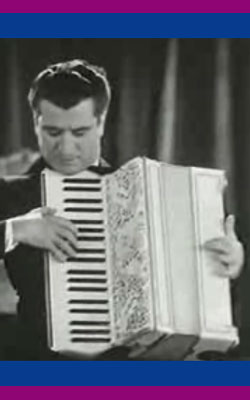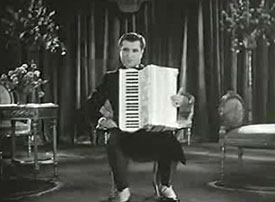 Guido Deiro: World's Foremost Piano-Accordionist (1929) opens with Guido seated in a very short chair in front of a curtain, a high-backed couch behind him, & other pointless furnishings on the stage. He's performing Vincenzo Bellini's Overture from the Italian opera I Capuleti e I Montecchi (1830).
Guido Deiro: World's Foremost Piano-Accordionist (1929) opens with Guido seated in a very short chair in front of a curtain, a high-backed couch behind him, & other pointless furnishings on the stage. He's performing Vincenzo Bellini's Overture from the Italian opera I Capuleti e I Montecchi (1830).
Highbrow music on a lowbrow instrument was not a natural & those of us who prefer vintage jazz aren't going to get the most out of Guido. He is regarded as having been the first nationally popular accordionist, & started the instrument on its rise among teenage boys until the rock era kicked the snarky instrument aside in favor of the forever-after to be preferred guitar.
Among Guido's many "firsts" with the accordion was the first phonograph recording of an accordion, first radio performance of solo accordion, coined the clumsy term "piano-accordion" which the public resisted, & starred in the first nationally huckstered "you too can be an accordion star" promotionals, & the first sound film of accordion music.
Other achievements included composing the music for the Broadway hit Kismet & hornswoggling a young Mae West into marrying him in secret (though in fact she was legally still married to dancer Frank Wallace). The marriage to Guido lasted a whopping four years during which they had a vaudeville act together, & Mae later said of their sexual prowess together, "I wanted to do it morning, noon, & night with him. That's all I wanted to do."
He alas was also unfaithful, & so was she. So she divorced him when she was old enough to bonk herself on the forehead asking, "What the hell?" She thereafter lived by her slogan, "Marriage is a great institution. I'm not ready for an institution."
"The Overture" dithers on for about two & a half minutes that seem like hours. It's starts off as the kind of romantic tune you might play for some seniorita on her balcony from a moonlit garden, & she'd be laughing with her girlfriends about the geek in the garden for a week. It builds to appropriate chase-music for a silent movie.
For his second abysmal number, we're treated to a number from Riccardo Drigo's Les millions D'Arlequin; aka, Harleqinade, a ballet composed in St. Petersberg in 1900, though featuring characters from the French pantomime stage.
It might be pretty interesting backing up the lovelorn antics of Pierrot, Pierette, & Harlequin, or even if fully orchestrated; but as a stand-alone number performed by one fellow who appears to have been wheeled out of a cryogenic chamber, it's not much.
Guido still isn't using any of the furniture except the low chair, still barely moving any part of his body except one hand over the keys. He tinkles along sounding like a beggar at a carnival somewhere in the suburbs of Paris, lacking only a tin cup to drop a sou or a nickel. That's actually kind of cool & of the two numbers this one's least annoying.
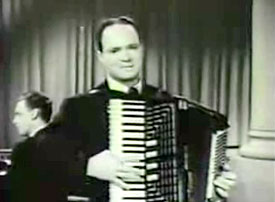 Starring "Charles Magnante (world's greatest accordionist) & his Trio," Tantalizin' (1946) starts right off with some quick finger work up & down the keyboard. Charles had been playing accordion jazz since the Roaring Twenties & manages to make some okay sounding noise with his instrument. Starring "Charles Magnante (world's greatest accordionist) & his Trio," Tantalizin' (1946) starts right off with some quick finger work up & down the keyboard. Charles had been playing accordion jazz since the Roaring Twenties & manages to make some okay sounding noise with his instrument.
There are jazz heroes whose instrument is the accordion (Frankie Ross comes to mind). But Magnante is no jazz hero; he's an accordion hero who only an accordion student could enjoy. He likely made more money selling sheet music to amateur accordionists than ever he made seelling records to anyone who loved his music per se.
Magnante's material is charitably categorized conventional for accordion. He was a minor radio star in the 1940s, with a trio of changeable personnel whose names rarely mattered. With his trio, he was NBC Radio's answer to CBS Radio's equally banal The Three Suns.
He stands with exactly as much charisma as an accordion calls for, vis, none, & plays along with a guitarist, a basist & a pianist, playing nothing at all remarkable.
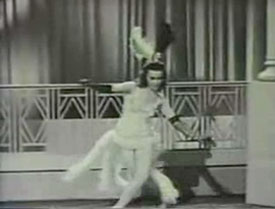 Waltz a la Accordion (1946) features not only Charles Magnante & His Trio playing "The Minute Waltz," but also features dancer Suzanne Graves, in a vain attempt of director William Forest Crouch to invest something entertaining in these awful soundies.
Waltz a la Accordion (1946) features not only Charles Magnante & His Trio playing "The Minute Waltz," but also features dancer Suzanne Graves, in a vain attempt of director William Forest Crouch to invest something entertaining in these awful soundies.
It starts out with Charles & his three accompanyists, a tiny solo for George Wright on Hammond organ, then Charles does his rapid dull keyboarding on the squeeze box.
As these short films were made for Mills Panoram visual jukeboxes, which was largely a youth market & in the '40s a soldiers-on-leave market, such soundies generally needed more than a guy who stands stock still with an accordion, or no one would ever plunk down their dime.
Therefdore, out runs skimpily clad Suzanne Graves. She traipses around in much more of a burlesque show prance than a dance, with stripper opera gloves, feathers poking up from her head, some high-kicks.
The scene then cuts back to Charles & Trio then back to stripper style prancing. There's a five-second organ solo & more accordion to waltz time as Suzanne shimmies rather than waltzes. There's no sense that the dancer was on the set the same day as Charles.
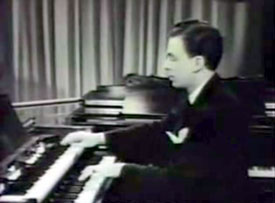 A third soundie is Andalucia (1946) with Charles Magnante & His Trio. It begins with a nice simple guitar-picking intro by Jack Smith (not Tony Mottola who traded off with Jack on radio gigs), then Charles does the accordion standard.
A third soundie is Andalucia (1946) with Charles Magnante & His Trio. It begins with a nice simple guitar-picking intro by Jack Smith (not Tony Mottola who traded off with Jack on radio gigs), then Charles does the accordion standard.
As all these soundies were filmed back to back, the trio is in the same array as the others, not one of the four guys conveying any showmanship. Disney robot orchestras have more body movement.
But playing the tune at the lowest notes of the accordion & long Hammond notes from George Wright mostly in background & some very melodic electric guitar passages from Jack, this comes off as Exotica Jazz & fairly decent musically compared to their other soundies.
It's hard to even hear bassist Eugene Ettore, however, who seems not to have been properly miked when the sound was recorded a day earlier, the soundies themselves being mimed.
copyright © by Paghat the Ratgirl
|
